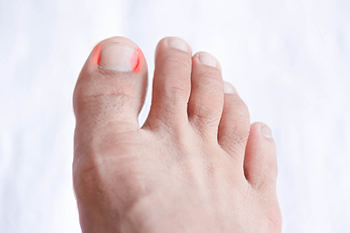 The big toe is negatively affected when an ingrown toenail develops. It can happen as a result of wearing shoes that do not have ample room for the toes to move freely in. An additional reason why this condition may occur can include trimming the toenails improperly. This may cause moderate pain and discomfort, and an infection may occur if there is a lack of treatment. Common symptoms of an ingrown toenail can include swelling and redness on the outer edges of the nail, and it may be difficult to wear shoes. Moderate relief may be found when the affected toe is soaked in warm water several times per day, and the nail is gently pulled away from the side of the toe. If you are afflicted with an ingrown toenail, it is suggested that you consult with a podiatrist who can offer the best treatment for you.
The big toe is negatively affected when an ingrown toenail develops. It can happen as a result of wearing shoes that do not have ample room for the toes to move freely in. An additional reason why this condition may occur can include trimming the toenails improperly. This may cause moderate pain and discomfort, and an infection may occur if there is a lack of treatment. Common symptoms of an ingrown toenail can include swelling and redness on the outer edges of the nail, and it may be difficult to wear shoes. Moderate relief may be found when the affected toe is soaked in warm water several times per day, and the nail is gently pulled away from the side of the toe. If you are afflicted with an ingrown toenail, it is suggested that you consult with a podiatrist who can offer the best treatment for you.
Ingrown toenails can become painful if they are not treated properly. For more information about ingrown toenails, contact Dr. Jeffrey Wachtel of Wachtel Family Foot Care. Our doctor can provide the care you need to keep you pain-free and on your feet.
Ingrown Toenails
Ingrown toenails occur when a toenail grows sideways into the bed of the nail, causing pain, swelling, and possibly infection.
Causes
- Bacterial infections
- Improper nail cutting such as cutting it too short or not straight across
- Trauma to the toe, such as stubbing, which causes the nail to grow back irregularly
- Ill-fitting shoes that bunch the toes too close together
- Genetic predisposition
Prevention
Because ingrown toenails are not something found outside of shoe-wearing cultures, going barefoot as often as possible will decrease the likeliness of developing ingrown toenails. Wearing proper fitting shoes and using proper cutting techniques will also help decrease your risk of developing ingrown toenails.
Treatment
Ingrown toenails are a very treatable foot condition. In minor cases, soaking the affected area in salt or antibacterial soaps will not only help with the ingrown nail itself, but also help prevent any infections from occurring. In more severe cases, surgery is an option. In either case, speaking to your podiatrist about this condition will help you get a better understanding of specific treatment options that are right for you.
If you have any questions please feel free to contact our office located in Lansdale, PA. We offer the newest diagnostic and treatment technologies for all your foot and ankle needs.




